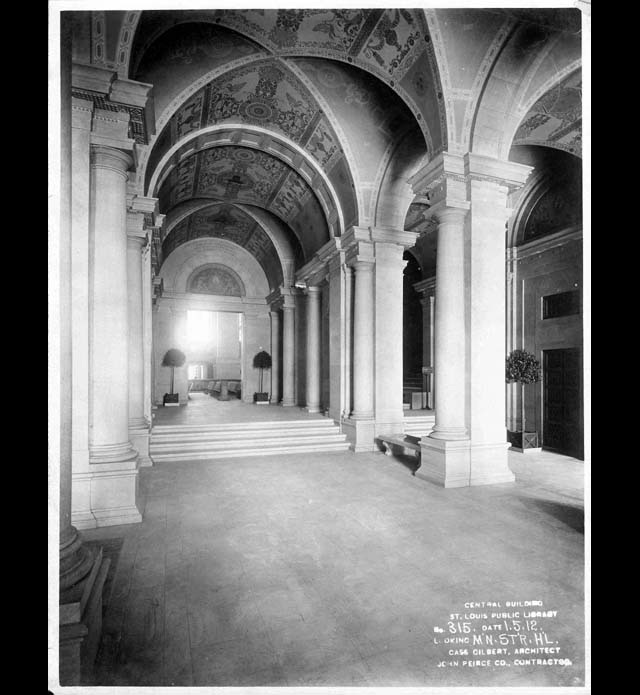Construction A Century Ago
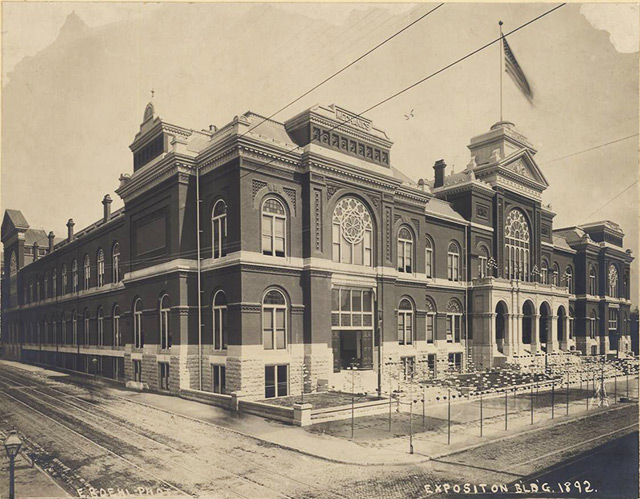
There was great interest in where the new library would be built. The location eventually agreed upon was occupied by the massive St. Louis Exposition and Music Hall. A mere 20 years old, this building might be thought of as an early counterpart to the present day America’s Center.
This view, taken at the corner of Olive and 14th Streets, shows that the Exposition Hall extended all the way from Olive Street to St. Charles: Locust Street didn’t exist between 14th and 13th Streets.

The Exposition Hall itself has a fascinating history. A variety of enormous rooms held significant events in the nation’s history. Grover Cleveland was nominated for the presidency in this building. On at least one occasion, the floor of the main hall was deliberately flooded and a “Water Hippodrome” performance mounted.

The site for the original library was actually quite complex, calling for the property to be divided between the new library, the creation of what is now Lucas Park, and the extension of Locust Street between 13th and 14th. Records indicate that many neighbors opposed extending Locust – fearing an invasion of new traffic into what had been exclusive Lucas Place. The new stretch of Locust was won by terming it a ‘park road’, which could be built without legislative approval.
As the Library prepared for the restoration of Central Library in 2010 - after Central Library had occupied the site for more than a century - it was found that the title to the land was still not entirely clear. It took a special approval of the Board of Aldermen, establishing clear ownership by the St. Louis Public Library, to allow construction to begin.
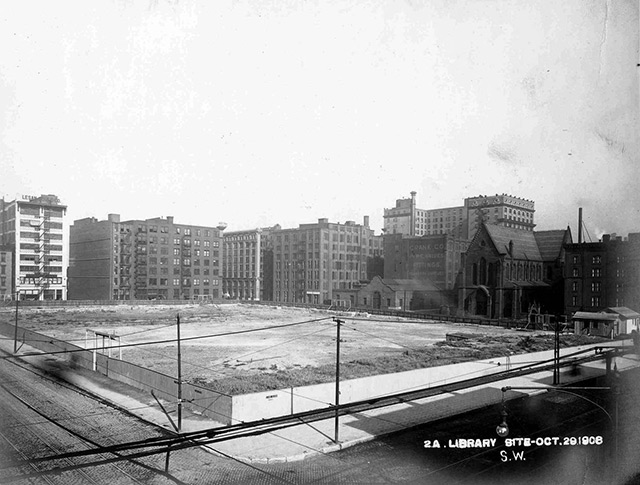
Taken from virtually the same position as the picture of the Exposition Hall in 1892, this picture taken in October of 1908, shows the Hall demolished and the site ready for construction of the new library to begin. Many of the buildings in this photograph still exist. Note that the lovely tower of Christ Church Episcopal Cathedral is yet to be built – it will appear in later photographs as progress on Central moves forward.
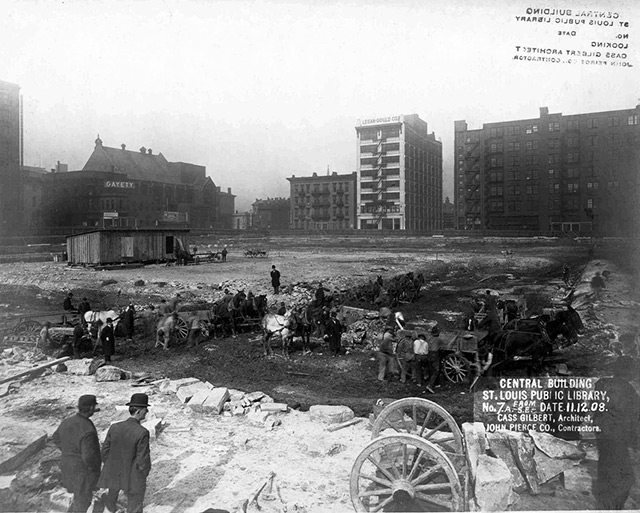
It is hard to imagine, from the perspective of the 21st century, the labor that went into building a great structure such as Central Library a hundred years ago. Here one sees teams of mules being used to prepare the site.
The city around us is revealed in these photographs taken to document Central Library’s construction. This view, looking northwest from Olive, shows the Gaiety Theatre at the corner of Locust & 14th Streets. Originally the august First Presbyterian Church, the building had been repurposed as its congregation fled the changes encroaching on once-exclusive Lucas Place. The church tower has been demolished, and the sanctuary turned into the Gaiety Burlesque Theatre – a name which had a very different meaning in 1908. Today, all traces of the church/theatre are gone and the site has been a parking lot for many years.
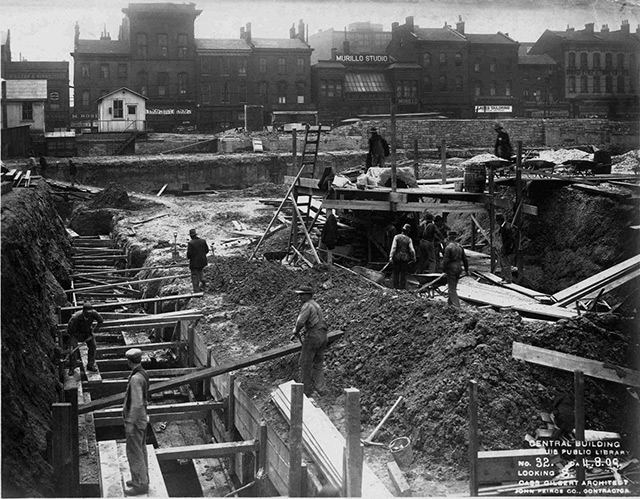
Central Library required massive foundations to carry the weight of the books – even libraries built today require much heavier load capacity than normal construction.
This photograph, taken in April 1909, looks almost directly south across Olive Street and shows the buildings and businesses that lined the south side of Olive in the early part of the century. Every one of these buildings is long gone, and the space occupied by the park that faces the Soldiers Memorial.
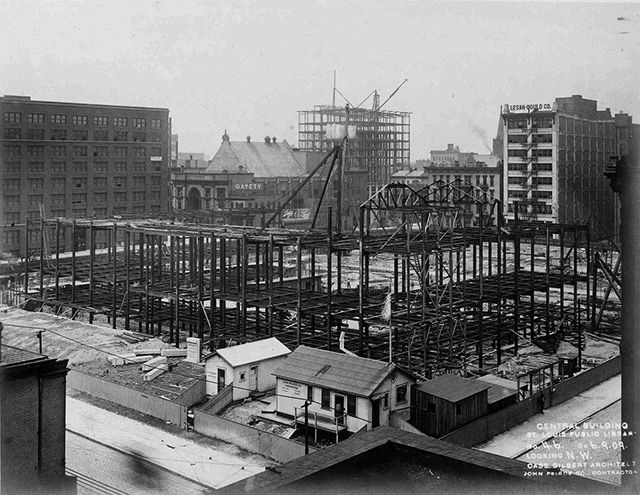
The construction photographs themselves are fascinating. It was very unusual at the time to photograph a construction project so thoroughly (for that matter it is unusual today.) Almost 400 large format photographs of the highest quality then available document every aspect of construction from the site work to the opening ceremony.
Another interesting aspect of this record is that one of the principal photographers was a woman – quite unusual at the time. Mattie Hewitt went on to have a prominent career as an architectural photographer, documenting many of the great estates and buildings of the late gilded age.
As Central Library’s massive steel frame (made of steel from the Carnegie companies outside of Pittsburg) takes shape, note the International Shoe Company Building (now the City Museum) rising on Washington Avenue.
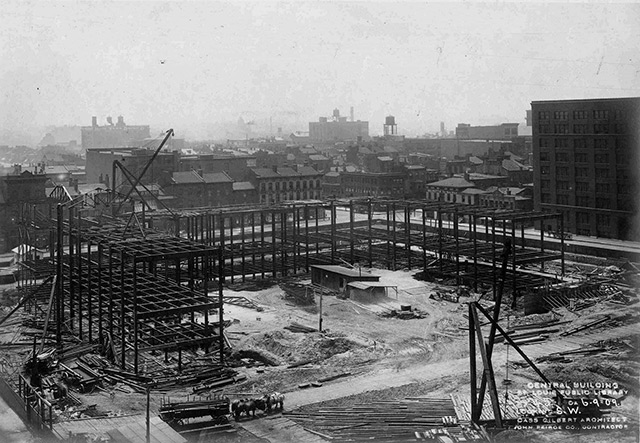
Looking in the opposite direction, the landscape around Central Library is almost wholly changed today – virtually none of the buildings in this photograph still exist. If we could see through St. Louis’ infamous smoky haze of the early century, we would be able to see the tower of Union Station rising in the distance.
In this photograph of June, 1909, the frame for the east, south, and west wings of Central Library are nearing completion. The enormous oval of the Great Hall in the center of the building, and the north, or stack tower wing, haven’t yet begun.
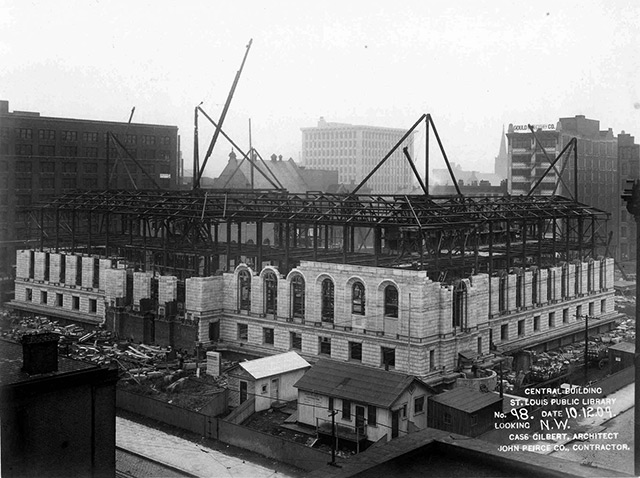
The exterior walls, of very hard and white granite from Mt. Waldo, Maine, rise in this picture from October, 1909. Note how much more quickly the more standardized construction of the International Shoe Company Building has progressed.
In 2011 granite was quarried from Mt. Waldo so that the restoration work matched the original stone.

As much of the three main facades near completion, work on the Great Hall is just beginning – seen here as the oval of steel begins to form in the heart of the building. The sequence of construction was vital in an age before cranes could lift steel and stone over the walls. Even in 2011, with all the modern equipment available to us, work in the heart of the building had to be very carefully timed and staged.
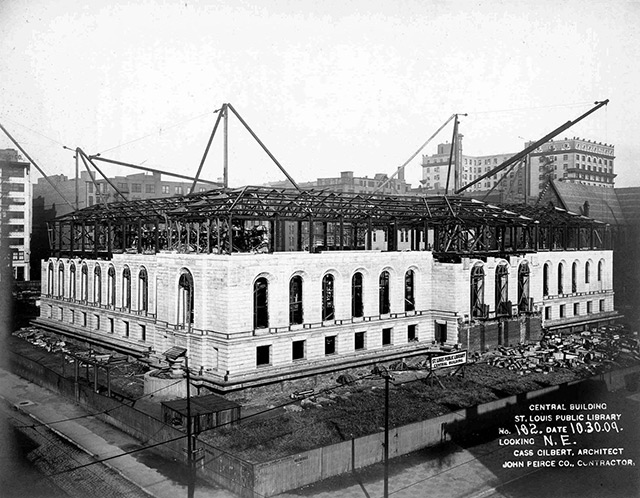
The many tons of Maine granite rise slowly up the building, October, 1909.
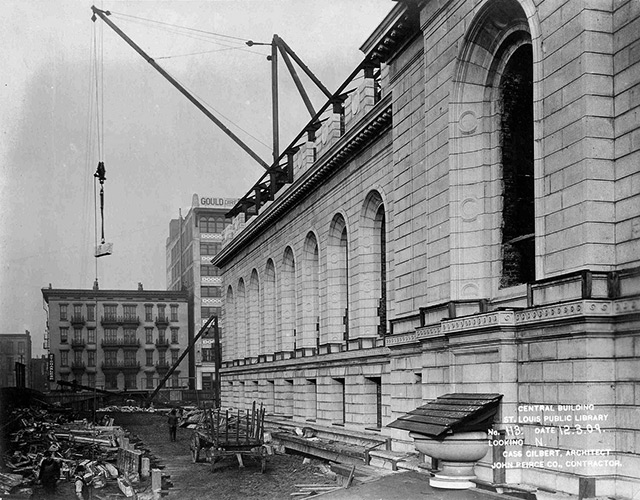
December 1909. A crane hoists a massive slab of granite into place on the third floor. The "Lion's Head" fountains were temporarily covered to protect them from the work above. These were restored as part of the recent renovation.
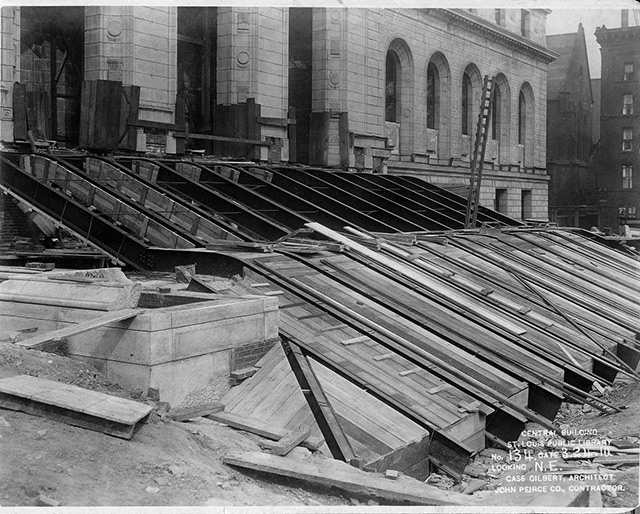
The great Olive Street staircase under construction. This March 1910 photograph reveals a structural element that troubled the library for years. Here one can see that the staircase is carried on huge steel beams – bent with great accuracy in Pittsburg and then shipped to St. Louis. These carried the massive weight of the cascade of granite stairs beneath which was an open storeroom. Gilbert used this same design years later at the Supreme Court building.
Over time the salt the library used to clear the ice and snow damaged the steel. By the late 1980s the steps were unsafe. As a preventative measure, the storeroom was filled with concrete to support the staircase. By 2000 the steps had deteriorated badly – to the point that the huge pieces of granite cracked and broke.
As part of the renovation all the stone was removed, carefully numbered, then restored to its original location over an entirely new support structure.
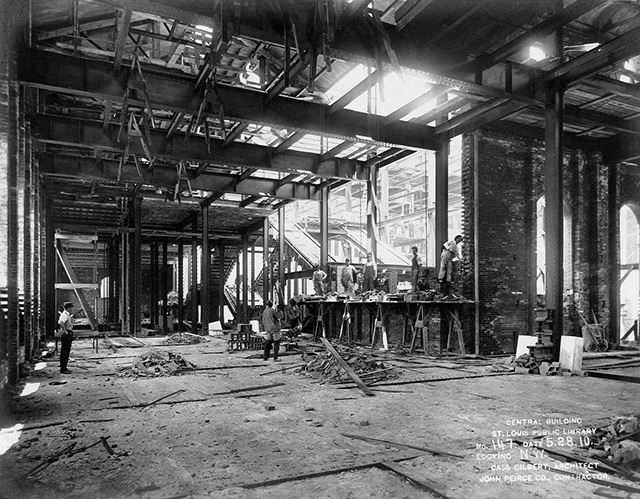
The vast spaces of the Central Library’s interior show clearly before the interior walls are completed. This picture, taken in May, 1910, is on the main floor in what would become the Periodicals Room. In the background, the double branches of the main staircase have taken shape. This is now the Business, Government & Law department.
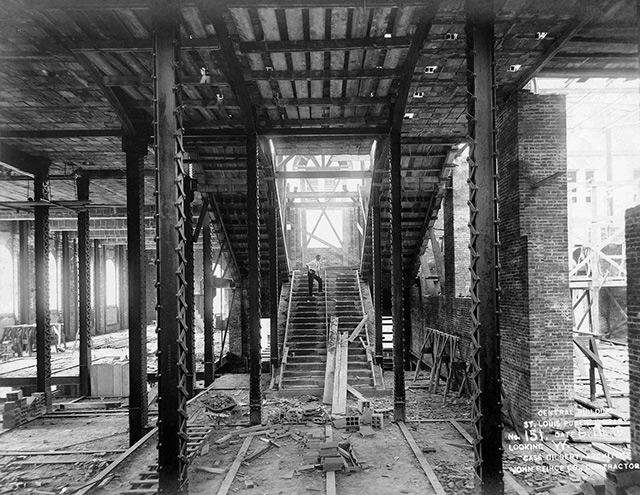
Everywhere the scale is monumental. June, 1910.
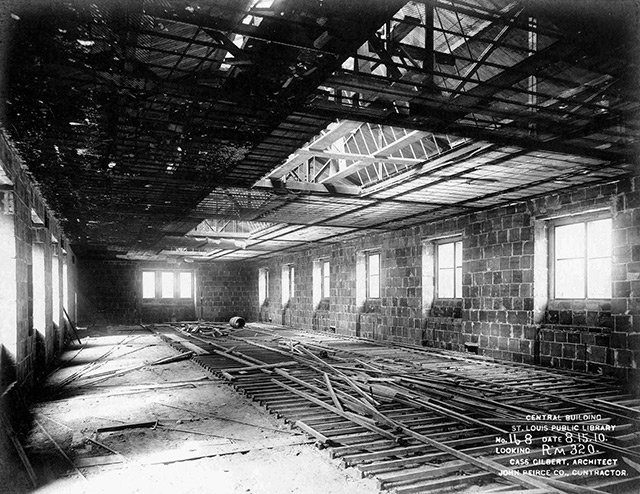
In this picture, we are on the third floor of Central Library, looking east. Soon after this photograph was taken in August, 1910, workers built divider walls in the space to create offices and work rooms. This area would become the business office, board room, and the director’s office.
As part of the renovation the dividing walls were torn down to create large public service rooms the size of the public rooms on the lower floors. This room is now the History & Geography department.
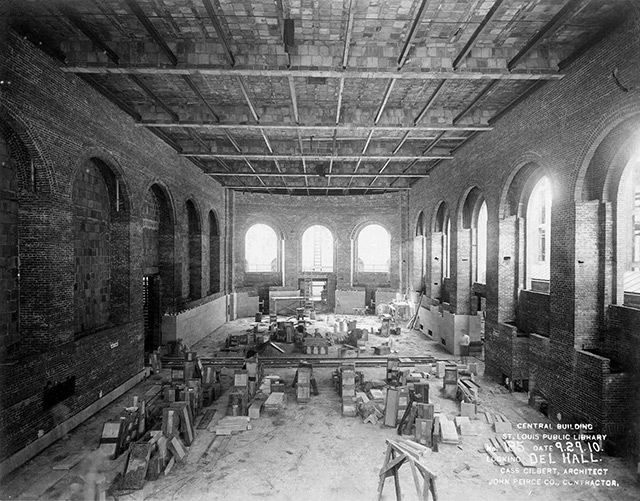
September 29, 1910. Workers install marble on the walls of the Great Hall. In 2011 electricians installing electrical and data wiring were challenged by the density of this marble. The shadowy figures in the foreground are workmen who could not stand still long enough to be photographed.
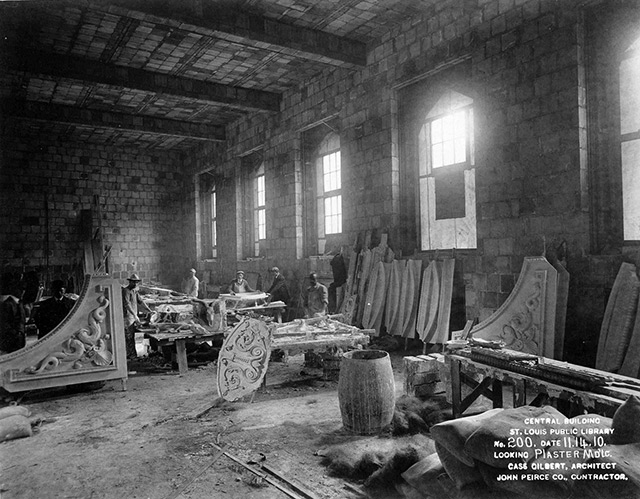
Craftsmen create plaster sections of the ceiling in the Periodicals Room modeled on Michelangelo’s design for the Laurentian Library in Florence. The windows in the room are covered up to keep the workers and the plaster warm in November 1910.
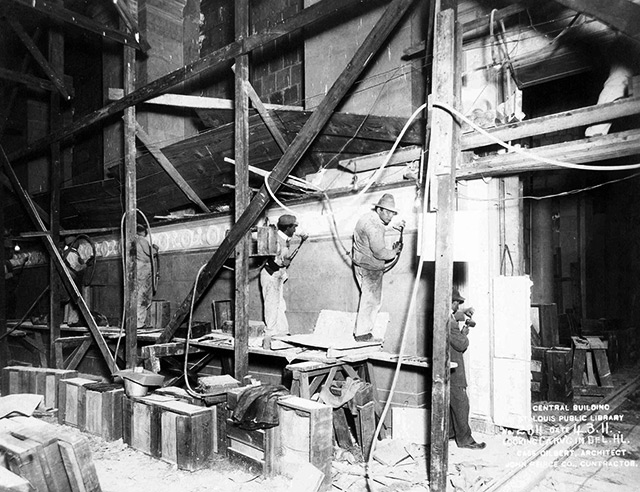
In the Great Hall the marble is carved after being installed on the walls. Craftsmen are using an early pneumatic carving system to start the ornamental work. The stonemason at the right does the finish work by hand.
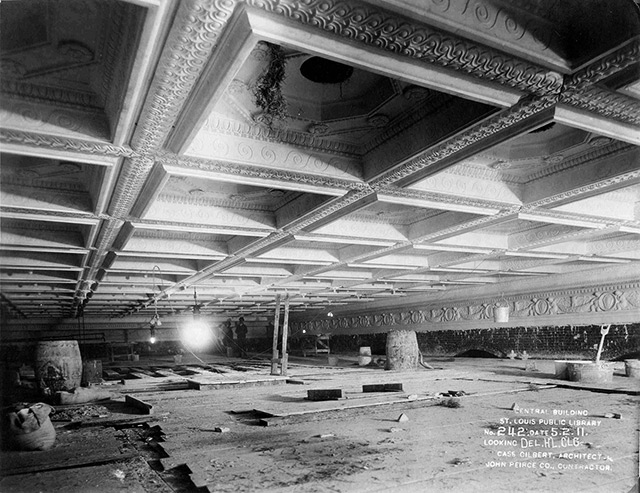
The Great Hall was originally named the Delivery Hall. Work on the 125 foot long ceiling takes place on scaffolding 35 feet above the floor. Workers install plaster molds which will be enhanced with paint and gold leaf.
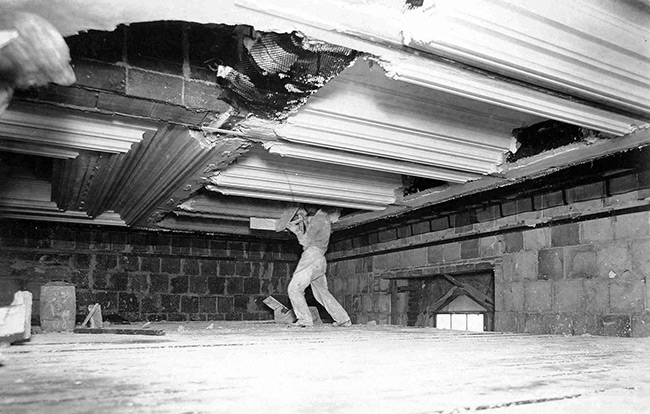
The amount of heavy labor necessary to create Central Library is staggering. Here a craftsman, standing on scaffolding far above the floor, presses into place a section of plaster for the magnificent ceiling in the Fine Arts Room.
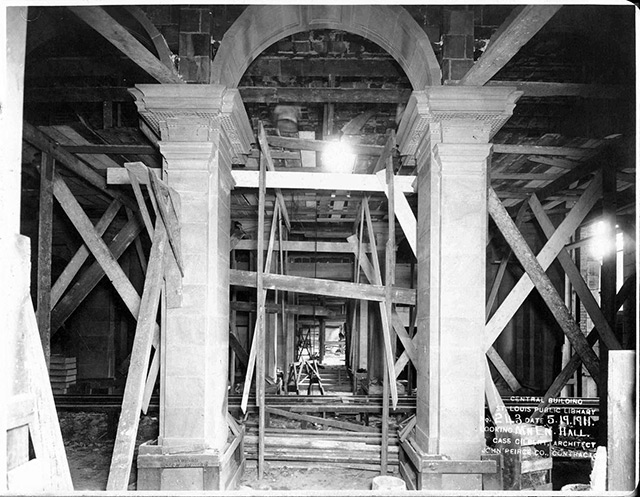
The marble arches of the Olive Street Foyer's colonnade – one of America’s great rooms – takes shape. Behind the classical surfaces of the marble and frescoed interiors an elaborate system of ductwork carries a then state-of-the-art ventilation system through the building. This system, as beautifully and skillfully constructed as any of the ornamental features, now distributes energy-efficient heating and cooling in the renovated building.
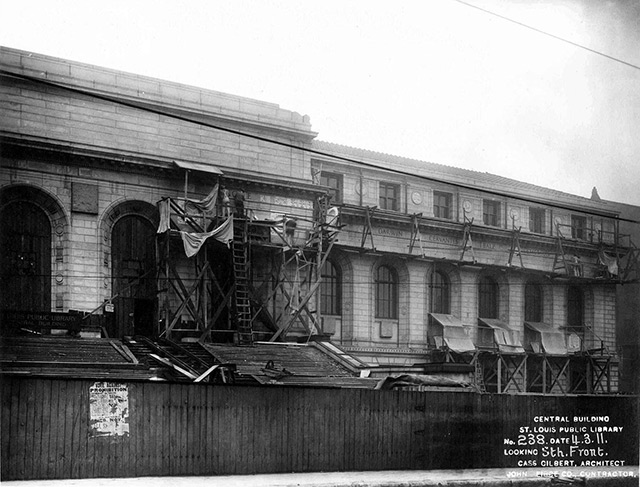
One of Central Library's famous features is the fine and very delicate carving that covers its exterior. The raw blocks of granite visible underneath the arched windows will be carved into detailed reproductions of printer's marks – one might think of them as early Trademark symbols – representing printing from Gutenberg to Morris. This April 1911 photograph shows workers carving the frieze of author's names above the granite stairs and the flimsy tents protecting the stonemasons working on the printer’s marks.
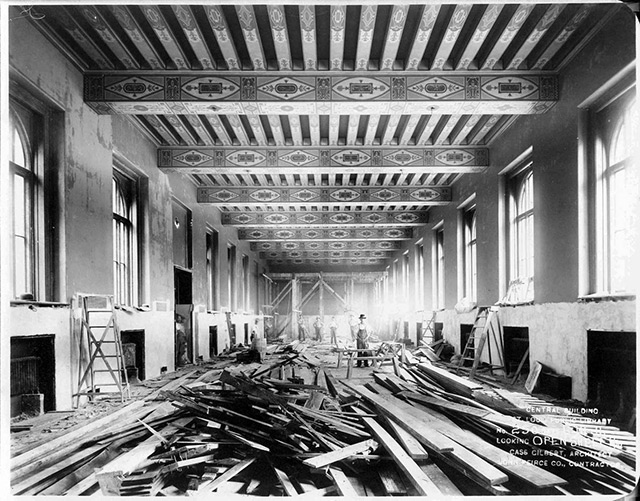
The Open Shelf Room – later the History Room - ready for the installation of the quartered oak bookcases in June, 1911. This is now the Social Sciences Room.
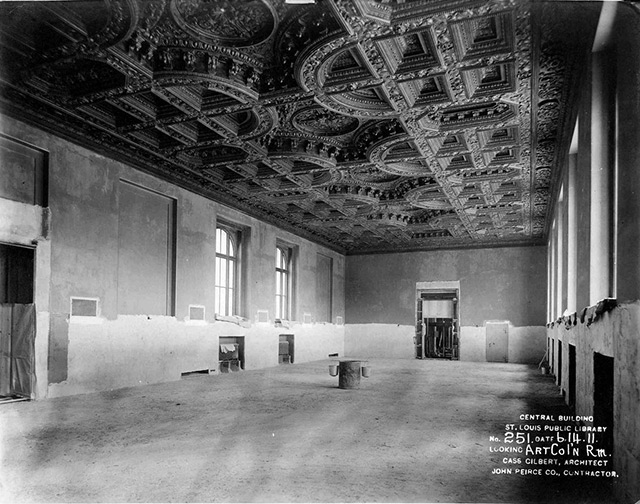
A rare photograph of the Fine Arts room showing the newly finished ceiling. It was fully restored as part of the 2011 renovation. To the right of the entrance is a small door leading to a vault for rare volumes. The door will be concealed by the room’s paneling.
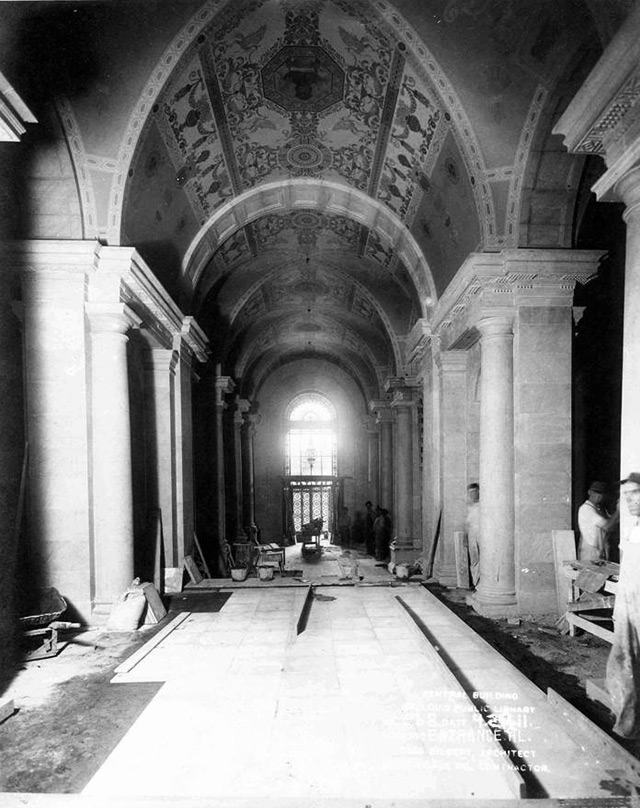
The beautiful Foyer continues to take shape: September 1911. Three months before opening day.
>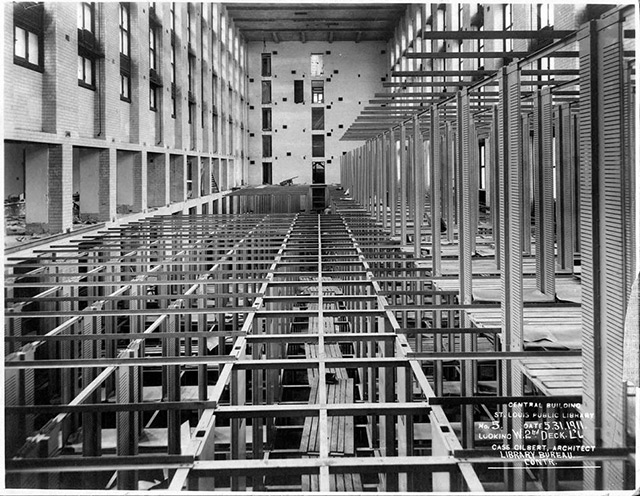
One of Central Library’s most astonishing spaces was never intended to be seen by the public. The extraordinary stack tower was a block long and seven stories high. It housed the majority of the Library’s collections and was accessible only to the staff.
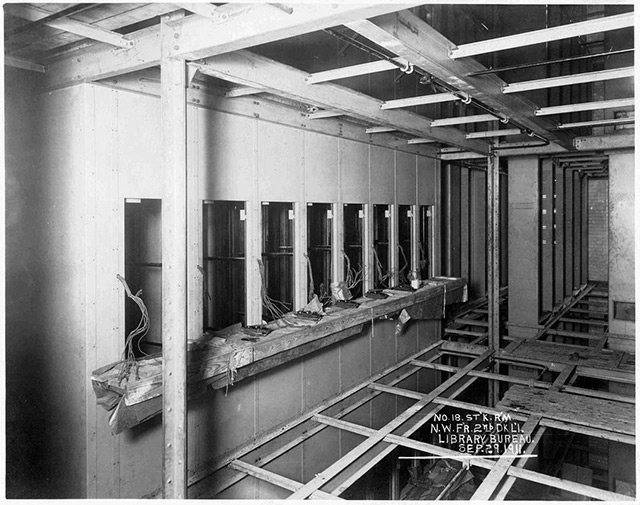
The stack tower contained Central’s famous glass floors, some of which were preserved and repurposed as a wall in the new atrium. The automatic elevators seen here were part of an elaborate system used to move books from the stack floors to the delivery area behind the Great Hall for patrons.
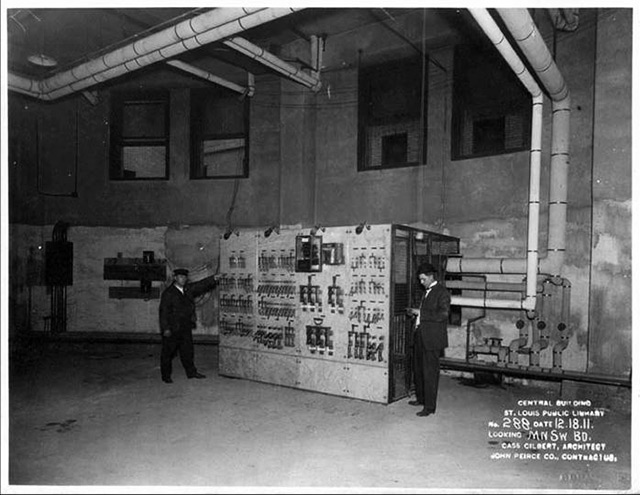
Gilbert, a classically trained architect, also used the latest technology available. St. Louis had poor air quality in this era. Two innovations tried at the Library were a central vacuuming system and an air-washing system. Unfortunately, both of these systems were ahead of their time and never functioned well. The brass heads of the vacuuming system can still be seen in some areas of Central Library. This is the "Dynamo Room" three weeks before Central Library opened to the public.
